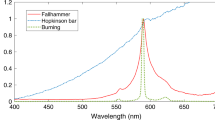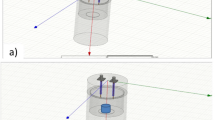Abstract
IN a letter to Nature, Kimball and Bates1 stated that they have succeeded in obtaining the band spectrum of AsH. The spectrum was excited in a carbon arc run in an atmosphere of hydrogen. The lower electrode formed the cathode of the arc and contained the arsenic. Two bands with origins at 32,380.2 cm.−1 and 31,639.9 cm.−1 were observed and attributed to AsH. The lines of the band at 32,380.2 cm.−1 are represented by the formula  We have tried to photograph the bands mentioned by Kimball and Bates but without success, although a large range of excitation conditions has been used.
We have tried to photograph the bands mentioned by Kimball and Bates but without success, although a large range of excitation conditions has been used.
This is a preview of subscription content, access via your institution
Access options
Subscribe to this journal
Receive 51 print issues and online access
$199.00 per year
only $3.90 per issue
Buy this article
- Purchase on Springer Link
- Instant access to full article PDF
Prices may be subject to local taxes which are calculated during checkout
Similar content being viewed by others
References
Kimball, G. E., and Bates, J. R., Nature, 128, 969 (1931).
Heimer, Tage, Z. Phys., 78, 771 (1932).
Pearse, R. W. B., and Gaydon, A. G., “The Identification of Molecular Spectra” (Chapman and Hall, London, 1950).
Author information
Authors and Affiliations
Rights and permissions
About this article
Cite this article
NAUDÉ, S., HUGO, T. Band Spectrum of AsH. Nature 170, 289–290 (1952). https://doi.org/10.1038/170289b0
Issue Date:
DOI: https://doi.org/10.1038/170289b0
Comments
By submitting a comment you agree to abide by our Terms and Community Guidelines. If you find something abusive or that does not comply with our terms or guidelines please flag it as inappropriate.



